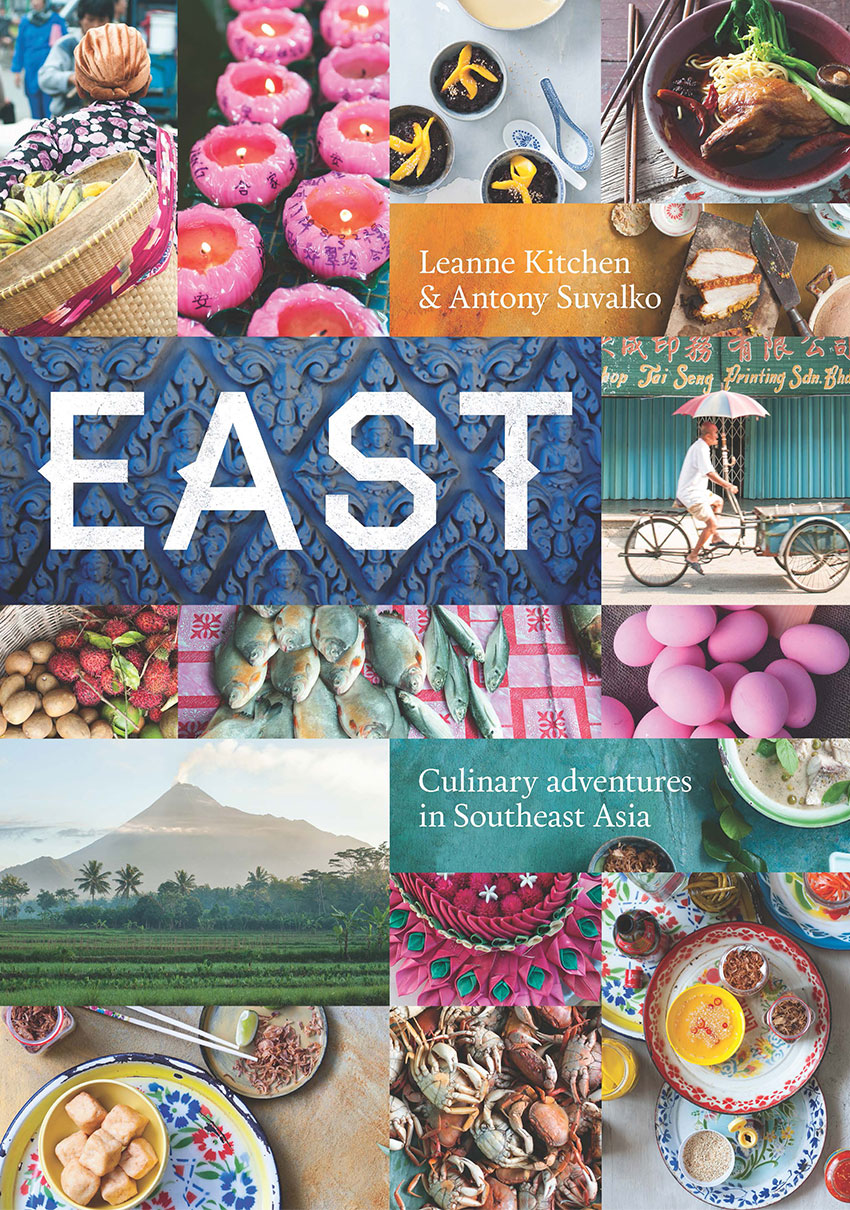From the smoky hawker stalls in Thailand and Malaysia and bustling markets in Vietnam and Indonesia, to the unexpected delights of Laos and Cambodia, the cuisines of Southeast Asia are a truly sensory experience. Bring the diverse flavours of Southeast Asia to your home kitchen withEAST – a collection of vibrant, flavoursome dishes that will transport you to faraway places. Food writer, chef and photographer Leanne Kitchen has joined with passionate foodie Antony Suvalko on this beautiful cookbook, with recipes that they themselves love to make and eat. It’s a culinary adventure for the global gourmand.
This is an edited extract from EAST by Leanne Kitchen & Antony Suvalko published byHardie Grant Books.
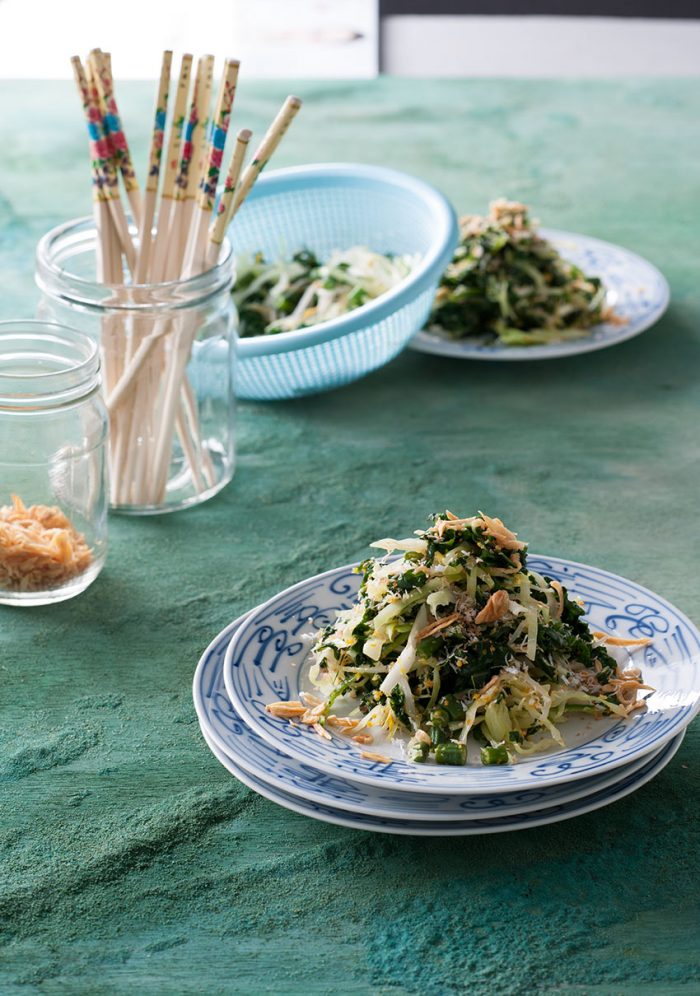
GREEN VEGETABLE SALAD WITH COCONUT
• S E R V E S 4 – 6 A S PA R T O F A S H A R E D M E A L •
We think Javanese food is really underrated. It tends to be more rustic than other Asian cuisines and maybe not as ‘pretty’, but it’s full of punchy flavours. This salad, known as urap in Bahasa, can be re-jigged according to whatever (usually green) vegetables are in season. Try blanched taro leaves, green beans or thinly sliced cucumbers. What isn’t negotiable, though, is the use of fresh grated coconut in the dressing – don’t even think of using desiccated. Luckily the thawed frozen stuff comes to the rescue of the time-strapped, so make sure you stock up on some.
300 g (101⁄2 oz) cabbage leaves
450 g (1 lb) silverbeet (Swiss chard) leaves (about 1 bunch),
white ribs removed
250 g (9 oz) snake (yard-long) beans, trimmed and cut
into 1 cm (1⁄2 in) pieces
250 g (9 oz) bean sprouts
2 large kaffir lime leaves, central vein removed,
very thinly sliced
2 large green chillies, trimmed and cut into
very fine matchsticks
50 g (13⁄4 oz/3⁄4 cup) Fried shallots (see page 26),
plus extra for serving
100 g (31⁄2 oz/1 cup) fresh grated or thawed frozen grated
coconut, toasted
D R E S S ING
4 garlic cloves, chopped
6 green bird’s eye chillies, chopped
3 teaspoons fresh turmeric, chopped,
or 3⁄4 teaspoon ground turmeric
6 large kaffir lime leaves, central vein removed,
chopped
60 g (2 oz/1⁄3 cup) shaved palm sugar (jaggery)
80 ml (21⁄2 fl oz/1⁄3 cup) lime juice
For the dressing, combine the garlic, chillies, turmeric and lime leaves in a small food processor and process until a smooth paste forms. Add the palm sugar and lime juice and process until smooth and the sugar has dissolved.
Meanwhile, bring a saucepan fitted with a large steamer and half-filled with salted water to the boil over high heat. Add the cabbage leaves and cook, covered, for 2–3 minutes or until softened. Using tongs, transfer to a colander and leave to drain.
Put the silverbeet in the steamer and cook for 1–2 minutes or until wilted then transfer to the colander. Cook the snake beans in the same way for 2–3 minutes, and the bean sprouts for 1 minute, then cool the vegetables to room temperature.
Thinly slice the cabbage and silverbeet and combine in a large bowl with the other steamed vegetables, the sliced lime leaves, chillies, fried shallots and 70 g (21⁄2 oz/2⁄3 cup) of the coconut. Add the dressing, season well with salt and freshly ground black pepper then toss to coat. Serve immediately with the remaining coconut and the extra fried shallots scattered on top.
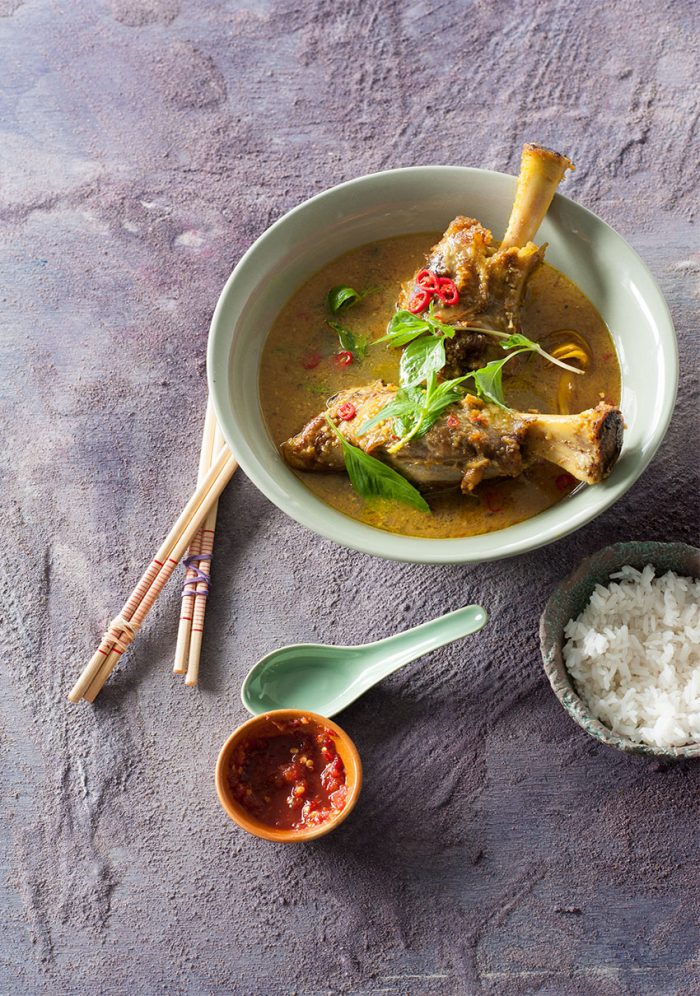
LAMB SHANK CURRY
• S E RVE S 4 – 6 •
As Indonesia is a predominantly Muslim country, beef and goat are widely eaten. Lamb fits the halal profile too and, although not as common, is also consumed. Lamb shanks, with their fall-apart tenderness and sweet meaty savour, work perfectly with assertive curry flavours, even though lamb cooked in large pieces like this is not strictly traditional. Indonesian curries can be complex, using both plenty of dry spices (cardamom, nutmeg, coriander, cloves and the like) as well as ‘wet’ aromatics like lemongrass, fresh chillies, galangal and kaffir lime leaves.
8 frenched lamb shanks
21⁄2 tablespoons vegetable oil
21⁄2 tablespoons white vinegar
8 cardamom pods, bruised
6 whole cloves
large pinch of freshly grated nutmeg
2 lemongrass stems, bruised and tied in a knot
500 ml (17 fl oz/2 cups) coconut milk
PA S T E
11⁄2 tablespoons coriander seeds
1 teaspoon trasi (Indonesian shrimp paste)
8 large red Asian shallots, chopped
6 garlic cloves, chopped
8 large red chillies, chopped
11⁄2 tablespoons chopped fresh ginger
11⁄2 tablespoons chopped fresh galangal
1 tablespoon chopped fresh turmeric or
11⁄2 teaspoons ground turmeric
6 candlenuts, chopped
T O S E R V E
thinly sliced red bird’s eye chillies
Thai basil leaves
Chilli sambal
For the paste, heat a small, heavy-based frying pan over medium–low heat, add the coriander seeds and dry-fry, shaking the pan, for 3 minutes or until fragrant. Transfer to an electric spice grinder and grind to a coarse powder. Alternatively, use a mortar and pestle.
Wrap the trasi in foil. Heat a small, heavy-based frying pan over medium heat, add the wrapped trasi then dry-fry for 2 minutes on each side, or until fragrant. Cool and unwrap. Transfer to a food processor with the ground coriander seeds and remaining paste ingredients and process until a smooth paste forms, adding a little water if necessary.
In a wok or frying pan over medium–high heat, cook the lamb shanks in the oil, in batches, turning often, for 5 minutes or until browned all over. Transfer to a bowl.
Remove all but 2 tablespoons of the oil from the wok, add the paste and cook, stirring often, for 3 minutes or until fragrant. Return the meat to the wok and add the remaining ingredients, except the coconut milk. Add 1.5 litres (51 fl oz/6 cups) water or enough to just cover the shanks. Bring to a simmer, reduce the heat to low and cook for 11⁄2 hours or until the meat is tender.
Add the coconut milk, bring back to a simmer and cook for 10 minutes or until the meat is very tender.
Serve garnished with the sliced chilli and basil leaves, with the chilli sambal passed separately.
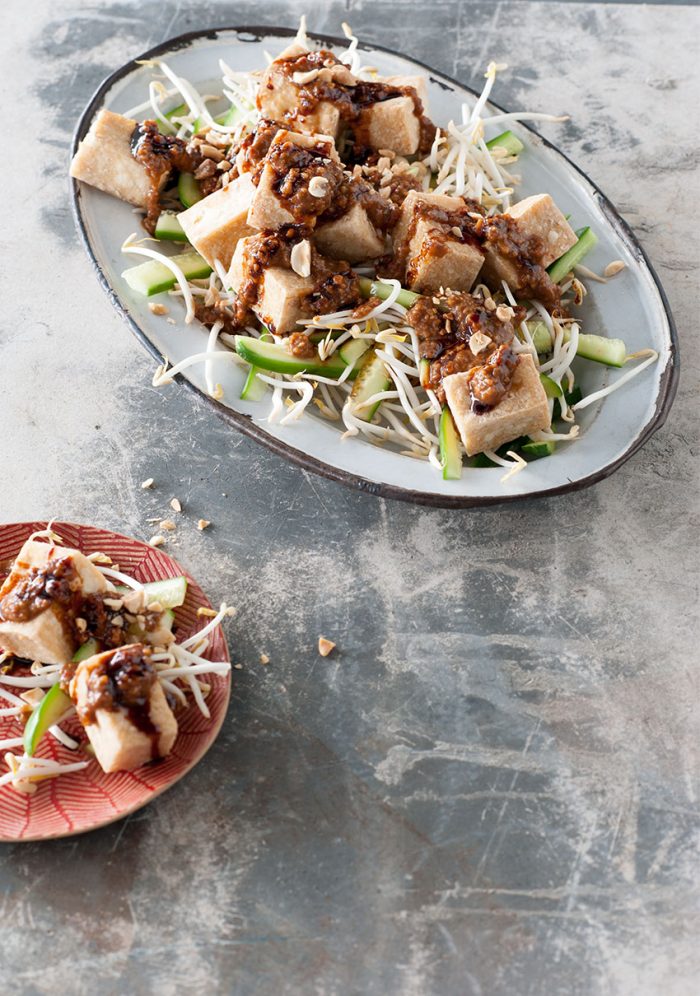
TOFU WITH PEANUT SAUCE
• S E R V E S 4 A S A L I G H T M E A L O R A S PA R T O F A S H A R E D M E A L •
The Indonesians, particularly on the island of Java, excel at cooking tempeh and tofu. Often these delicious (and cheap) staples are served in curries, or they are deep-fried, as in this recipe. Tofu particularly, because its own flavour is relatively bland, takes on other flavours readily and, if you always think of it as a wholly vegetarian food, think again. This dish, with its peanutty dressing, is gutsy and filling and oh so delicious. It will win over even the most avowed red meat eater.
200 g (7 oz) mung bean sprouts
4 Lebanese (short) cucumbers (about 500 g/1 lb 2 oz
in total), trimmed and cut into batons
peanut oil for deep-frying
600 g (1 lb 5 oz) firm tofu
rice flour for coating
50 g (13⁄4 oz/1⁄3 cup) roasted unsalted peanuts,
crushed
P E ANU T S AU C E
21⁄2 tablespoons shaved palm sugar (jaggery)
21⁄2 tablespoons tamarind pulp
250 ml (81⁄2 fl oz/1 cup) boiling water
5 red bird’s eye chillies, chopped
3 garlic cloves, chopped
160 g (51⁄2 oz/1 cup) roasted unsalted peanuts, chopped
1 tablespoon kecap manis
1 tablespoon lime juice
For the peanut sauce, put the sugar in a small saucepan over medium heat with 125 ml (4 fl oz/1⁄2 cup) water and heat until the sugar has dissolved. Remove from the heat.
Meanwhile, combine the tamarind pulp with the boiling water in a bowl and stand for 20 minutes. Strain the mixture through a sieve, using your fingers to press down on the solids to extract as much liquid as possible. Discard the solids.
Combine the chillies and garlic in a food processor and process until a smooth paste forms. Add the peanuts, tamarind liquid, palm sugar mixture and kecap manis and process until a chunky sauce forms, adding a little water if necessary – there should be a little texture in the peanuts. Transfer the mixture to a small
saucepan and bring to a simmer over medium–low heat. Cook, stirring often, over low heat for 4–5 minutes, until the flavours develop. Add a little more water if the mixture becomes too thick. Stir in the lime juice and remove from the heat.
Toss the mung bean sprouts and cucumber in a bowl then divide among plates or place on a large platter.
Heat enough peanut oil for deep-frying in a large saucepan or wok to 170°C (340°F), or until a cube of bread turns golden in 20 seconds.
Meanwhile cut the tofu into pieces about 5 x 2.5 cm (2 x 1 in) and toss them in the rice flour to coat, shaking off any excess flour. Fry the tofu pieces, in batches, for 4–5 minutes or until golden and crisp. Place them on top of the vegetables, pour over the sauce, scatter over the crushed peanuts and serve.
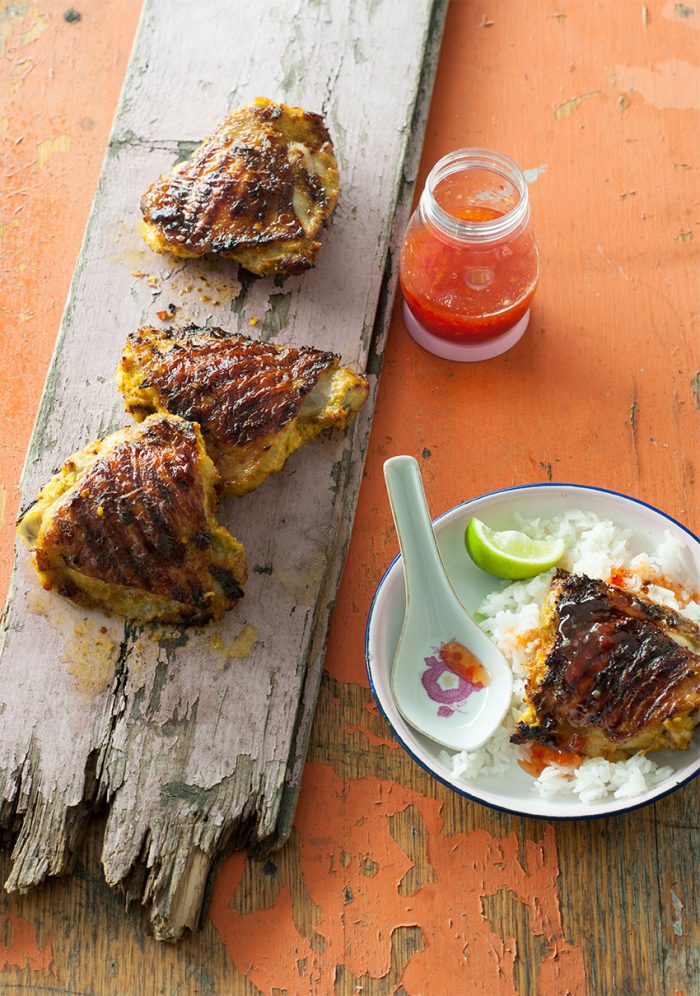
COCONUT GRILLED CHICKEN
• S E R V E S 6 – 8 A S PA R T O F A S H A R E D M E A L •
Cooking this chicken might make a slight mess of your barbecue, but it’s completely worth it, especially if you cook it as the Thais do, over coals. This is an easy dish that practically everyone loves. If you feel like cooking a Thai feast, it goes perfectly with a Thai-style salad and rice, plus a curry and a simple stir-fry of leafy vegetables. You can cut each thigh in half before marinating, if you are sharing this among a large number of people. Just reduce the cooking time by 6 minutes.
10 chicken thighs on the bone (about 2 kg/4 lb 6 oz in total)
6 large dried red chillies, soaked in boiling water for 30 minutes, drained
3 lemongrass stems, white part only, chopped
2 teaspoons ground coriander
6 garlic cloves, chopped
2 tablespoons chopped fresh turmeric
or 2 teaspoons ground turmeric
300 ml (10 fl oz) coconut milk
60 ml (2 fl oz/1⁄4 cup) fish sauce
1 teaspoon ground white pepper
Sweet chilli sauce (see page 15) to serve
lime wedges to serve
Using a large, sharp knife, trim the excess bone of each chicken thigh to give a nice shape. Set aside.
Combine the drained chillies in a food processor with the lemongrass, coriander, garlic and turmeric and process until a smooth paste forms. Alternatively, use a mortar and pestle.
Combine with the coconut milk, fish sauce and pepper in a large bowl and add the chicken pieces. Using your hands, turn the chicken to coat well in the mixture. Cover the bowl with plastic wrap and refrigerate for 8 hours or overnight.
Remove the chicken from the refrigerator and bring it to room temperature. Drain the chicken well, reserving the marinade and brushing off any solids.
Heat a barbecue or chargrill pan to medium. Add the chicken and cook, turning occasionally and brushing the chicken with the reserved marinade from time to time, for about 20 minutes or until the chicken is cooked through. Serve with the sweet chilli sauce and lime wedges.
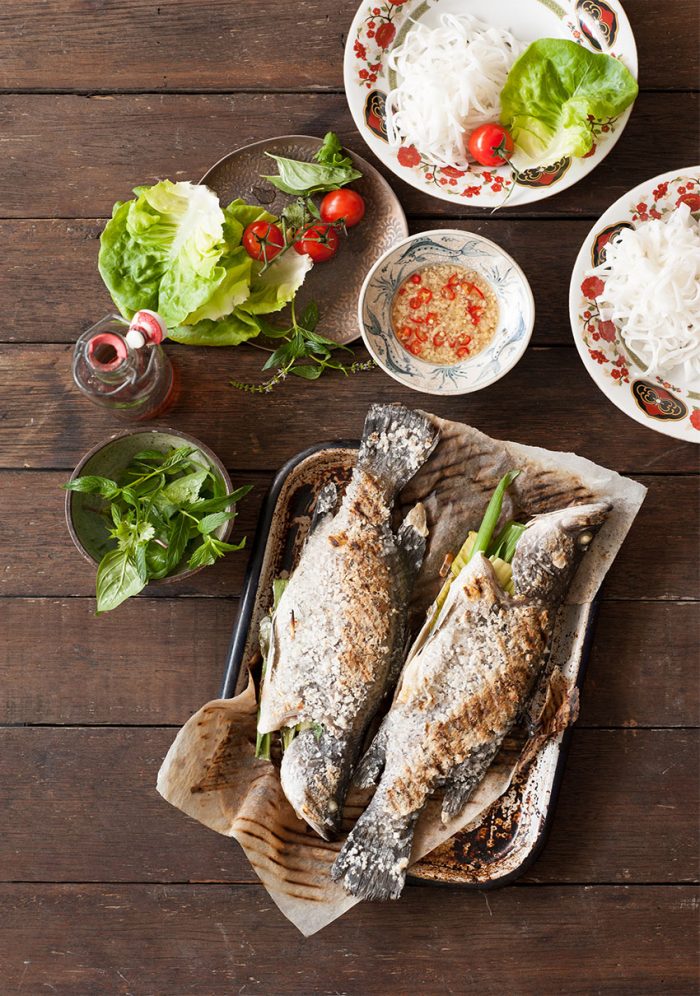
SALT-GRILLED FISH
• S E R V E S 4 •
We’ve enjoyed this wonderful cooking technique in Laos and Thailand. The salt crust protects the delicate fish from the heat of the barbecue and keeps the juices in. Traditionally an oily fish like mackerel is used, but here we’ve opted for barramundi. The key to getting the cooking right is to have an even, moderate heat source – not too fierce. Make sure the coals on the barbecue are spread out evenly before you start grilling, or if you are using a chargrill pan, that it conducts heat evenly.
4 lemongrass stems, bruised
4 pandan leaves, trimmed and bruised
4 spring onions (scallions), trimmed and
coarsely chopped
12 kaffir lime leaves, bruised
4 x 400 g (14 oz) whole barramundi, snapper
or bream, cleaned
60 g (2 oz/1⁄2 cup) cornflour (cornstarch)
100 g (31⁄2 oz/3⁄4 cup) coarse sea salt
S AU C E
60 ml (2 fl oz/1⁄4 cup) lime juice
60 ml (2 fl oz/1⁄4 cup) fish sauce
2 tablespoons shaved palm sugar (jaggery)
3 red bird’s eye chillies, finely sliced
3 garlic cloves, crushed
T O S E R V E
butter lettuce leaves, washed
cherry tomatoes
Thai basil leaves
Vietnamese mint leaves
coriander (cilantro) leaves
200 g (7 oz) thin fresh rice noodles, cooked according to the packet instructions
Divide the lemongrass, pandan leaves, spring onion and lime leaves among the fish cavities, then close each cavity using toothpicks or skewers to secure.
Mix the cornflour with 100 ml (31⁄2 fl oz) water to form a thick paste, then brush the mixture lightly over the fish. Coat the outside of each fish with salt, pressing it firmly so it adheres well – each fish should be lightly coated. Stand the fish at room temperature for 30 minutes or until the salt crust feels dry to the touch.
Heat a barbecue or chargrill pan to medium. Add the fish, in batches if necessary, and cook for 15–20 minutes, turning once, or until the flesh is cooked through.
For the sauce, combine all the ingredients in a bowl with 80 ml (21⁄2 fl oz/1⁄3 cup) water and stir until the sugar has dissolved.
Serve the fish with the lettuce leaves for wrapping, and with the tomatoes, herbs, noodles and sauce in separate bowls.
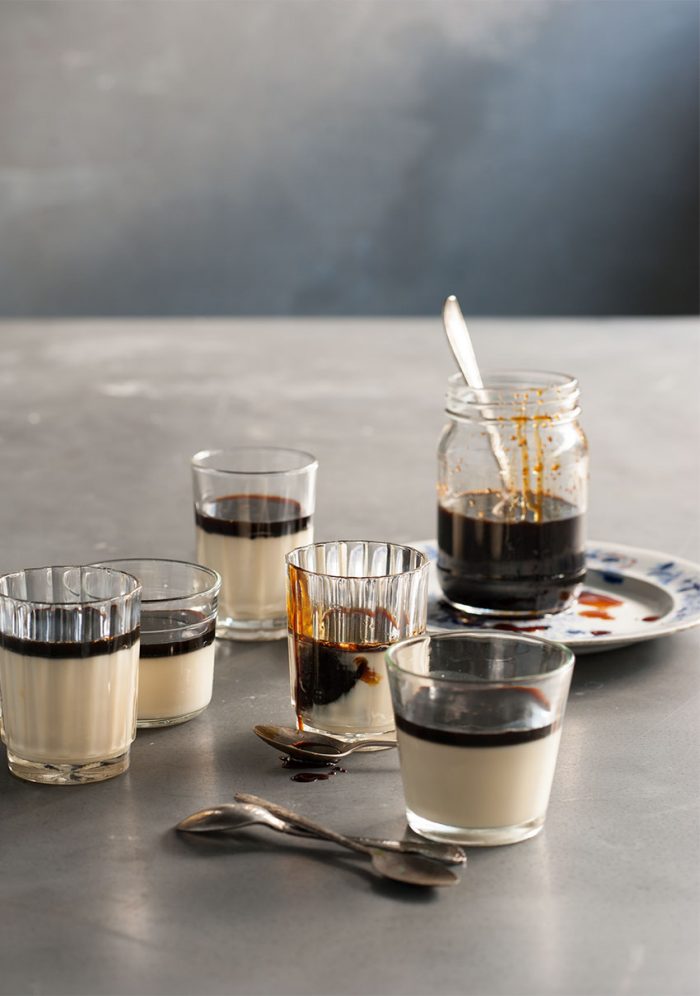
SOY MILK JELLIES WITH COFFEE SYRUP
• S E R V E S 6 •
Unusually for an Asian nation, the Vietnamese have a fondness for coffee – a taste they acquired from their French colonisers. (Interestingly, Vietnam supplies the world coffee trade with much of its robusta beans, most of which end up as instant coffee.) The Vietnamese enjoy their coffee strong and sweet, commonly serving it with lashings of condensed milk. Inspired by those flavours, this simple dessert is a wonderful combination of soothing, barely set milky jelly with the jolt of a strong, coffee-based syrup. The left-over syrup keeps well and tastes delicious spooned over ice cream.
21⁄2 teaspoons powdered gelatine
160 ml (51⁄2 fl oz) sweetened condensed milk
330 ml (11 fl oz) soy milk
270 g (91⁄2 oz/11⁄2 cups) chopped palm sugar (jaggery)
25 g (1 oz/1⁄3 cup) coarsely ground coffee beans
Sprinkle the gelatine over 2 tablespoons cold water in a cup or small bowl and stand for 5 minutes or until softened.
Meanwhile, combine the condensed and soy milks in a small saucepan and gently heat over medium–low heat – do not simmer. Stir in the gelatine mixture and cook, stirring, for 2 minutes or until the gelatine has dissolved. Cool to room temperature. Divide among six 175 ml (6 fl oz) glasses or serving bowls and refrigerate for 6 hours or overnight – the jellies will just be lightly set.
Combine the palm sugar and 400 ml (131⁄2 fl oz) water in a small saucepan and slowly bring to the boil over medium heat, stirring until the sugar has dissolved. Reduce the heat to low and simmer for 5 minutes or until slightly thickened. Add the coffee and cook for another 2 minutes for the flavours to infuse. Remove from the heat and cool to room temperature.
Strain the syrup through a fine-mesh sieve, discarding the solids, then refrigerate until cold.
Pour some of the syrup over the jellies and serve with the remaining syrup on the side.
EAST by Leanne Kitchen & Antony Suvalko is published by Hardie Grant Books $49.95 and is available in stores nationally.
